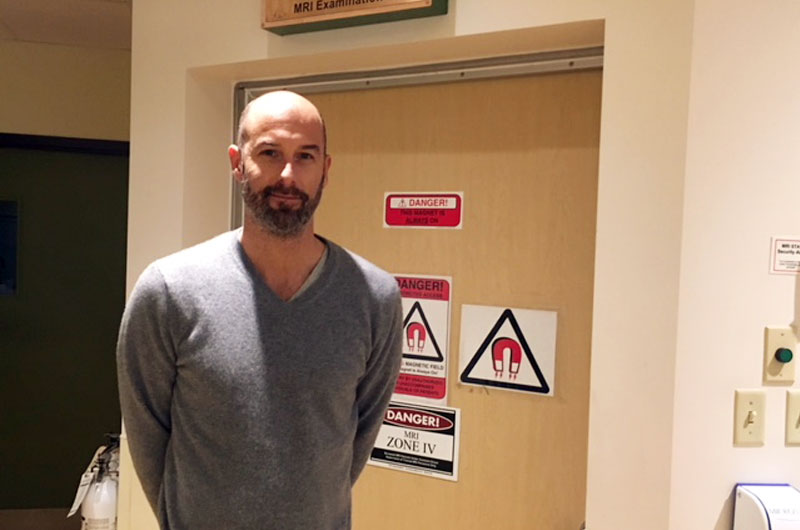Dr. Christian Baldauf
Feb 26, 2018 - Profiles
Q&A with Dr. Christian Baldauf on the importance appropriate imaging and the SWLHIN Medical Imaging Integrated Care Project.
Dr. Christian Baldauf
Feb 26, 2018 - Profiles
Q&A with Dr. Christian Baldauf on the importance appropriate imaging and the SWLHIN Medical Imaging Integrated Care Project.

Dr. Christian Baldauf is a radiologist with Owen Sound Medical Imaging and Physician Lead for the Medical Imaging Integrated Care Project with the SWLHIN. Dr. Baldauf completed his radiology training at McMaster University in Hamilton, Ontario and a fellowship in MRI focused on spine and brain at the University of Miami, Florida.
Dr. Baldauf interests include competitive sports and played university basketball as the captain of the Golden Griffins at Guelph University. He uses this team approach in his daily practice by getting involved with collaborative efforts to improve the health care system. This has led to his work on improving access and quality of imaging services within his region.
Medical Imaging Integrated Care Project:
Dr. Baldauf is currently the Physician Lead for the Medical Imaging Integrated Care Project, focused on optimizing access of MRI services, standardizing the quality of imaging, and improving appropriateness for patients across the region. Dr. Baldauf joined this project due to his interest in collaborative efforts to improve the delivery care across the health care system.
Choosing Wisely Canada: How have you incorporated the Choosing Wisely Canada recommendations into your practice?
As a radiologist, I find the recommendations on imaging very relevant to my practice. The recommendations provide you with best practice guidelines and allow you to take a step back and ask “is this study necessary?” For example, I like to refer to the recommendation related to imaging for low back pain. I can look at a patient’s symptoms and signs and see whether or not a scan would add any value to their care. Using this method allows us to recognize if we’re ordering appropriately or what next steps we have to take. In doing so, we ensure the right patient is receiving MRI studies, reduce unnecessary testing, and improve access to these services.
We addressed the issue of unnecessary imaging in our Medical Imaging Integrated Care Project. We saw many patients referred for MRI studies when the test would not change the outcome of the patient’s care plan. To improve this, we developed appropriateness checklists for knee and spine as a way of working with referring physicians to ensure an MRI requisition was absolutely necessary. By going through this checklist, you look at each patient’s individual case and determine whether the next appropriate step is an MRI scan. If not, we can offer alternative options and treatment plans for improving the patients care. It’s a great tool for referring physicians to make these types of decisions while also ensuring radiologists and surgeons are getting the important information they need.
CWC: What’s your approach to having conversations with patients about things they might not need?
As radiologists, we are involved with speaking with clinicians to let them know why an MRI study is necessary or not. We work collaboratively to ensure the patient knows why or why not they are receiving a test. Specifically, for the patient I think it’s important for them to know our doctrine as physicians is to do no harm. MRI studies can take up time or resources to come in for this particular test. If the information you’re going to obtain will not advance the patients care, you put them in difficult situation. They may receive another test if there was some finding on the initial scan, and this leads to more time and resources. It becomes a cycle of tests that may have not been necessary from the first point of contact. The key to avoiding these situations is having that conversation with your patient. Let them know about low-level imaging leading to high-level imaging. We see a lot of patients who are not surgical candidates, yet they are receiving high-level imaging. If we focus on these conversations, we can offer other clinical ways to support patients such as physiotherapy or exercise to make their bodies strong. In certain cases, this can prevent high-level imaging and potentially surgery.
CWC: What’s your motivation for being so involved in efforts to reduce unnecessary care?
One of the reasons I enjoy coaching basketball so much is working with a team. I constantly think about how this translates into my practice as a radiologist. Working with different clinicians and specialists, we can see how our work affects the overall health care system. If we work collaboratively and find ways to streamline the work that we do, we can avoid wasting necessary resources and ensure patients have access to high-quality care.
I’m also motivated by looking at the big picture of health care across Canada. Even though I am working within a region, I always think about how these protocol and best practices can be scaled. Can we find ways to do this type of work provincially or even nationally? I think the common goal for us all is to choose wisely, and make smart choices on how we utilize the health care system.
